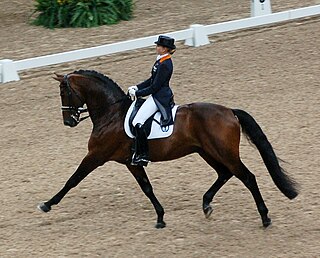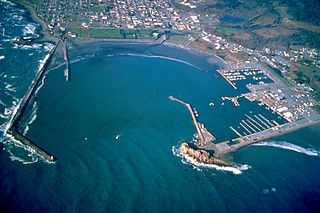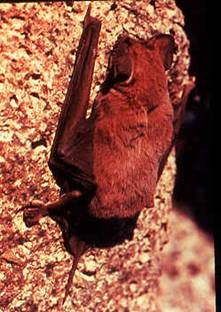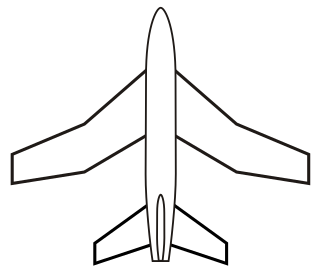
Surfing is a surface water sport in which an individual, a surfer, uses a board to ride on the forward section, or face, of a moving wave of water, which usually carries the surfer towards the shore. Waves suitable for surfing are primarily found on ocean shores, but can also be found in standing waves in the open ocean, in lakes, in rivers in the form of a tidal bore, or in wave pools.

Dressage is a form of horse riding performed in exhibition and competition, as well as an art sometimes pursued solely for the sake of mastery. As an equestrian sport defined by the International Equestrian Federation, dressage is described as "the highest expression of horse training" where "horse and rider are expected to perform from memory a series of predetermined movements."

Microbats constitute the suborder Microchiroptera within the order Chiroptera (bats). Bats have long been differentiated into Megachiroptera (megabats) and Microchiroptera, based on their size, the use of echolocation by the Microchiroptera and other features; molecular evidence suggests a somewhat different subdivision, as the microbats have been shown to be a paraphyletic group.

Crescent City is the only incorporated city and county seat of Del Norte County, California. Named for the crescent-shaped stretch of sandy beach south of the city, Crescent City had a total population of 6,676 in the 2020 census, down from 7,643 in the 2010 census. The population includes inmates at Pelican Bay State Prison, also within the city limits, and the former census-designated place Crescent City North annexed to the city. The city is also the site of the Redwood National Park headquarters, as well as the historic Battery Point Light. Due to the richness of the local Pacific Ocean waters and the related catch, and ease of access, Crescent City Harbor serves as home port for numerous commercial fishing vessels.
Bodyboarding is a water sport in which the surfer rides a bodyboard on the crest, face, and curl of a wave which is carrying the surfer towards the shore. Bodyboarding is also referred to as Boogieboarding due to the invention of the "Boogie Board" by Tom Morey in 1971.The average bodyboard consists of a short, rectangular piece of hydrodynamic foam. Bodyboarders typically use swim fins for additional propulsion and control while riding a breaking wave.

A surfboard is a narrow plank used in surfing. Surfboards are relatively light, but are strong enough to support an individual standing on them while riding an ocean wave. They were invented in ancient Hawaii, where they were known as papa he'e nalu in the Hawaiian language, they were usually made of wood from local trees, such as koa, and were often over 460 cm (15 ft) in length and extremely heavy. Major advances over the years include the addition of one or more fins (skegs) on the bottom rear of the board to improve directional stability, and numerous improvements in materials and shape.

Kiteboarding or kitesurfing is an extreme sport where the kiter uses the wind power with a large power kite to be pulled on a water, land or snow surface. It combines aspects of paragliding, surfing, windsurfing, skateboarding, snowboarding and wakeboarding. Kiteboarding is among the less expensive and the more convenient of the sailing sports.
Kneeboarding is a discipline of surfing where the rider paddles on his or her belly into a wave on a kneeboard, then rides the wave face typically on both knees. The typical kneeboard is between 150 to 200 cm in length, with a wide round nose and constructed of Glassfibre over a polyurethane foam core. Kneeboard designers however are known for their wild experimental excess and so most modern materials including various aerospace elements such as Titanium alloys, carbon fibre and kevlar in epoxy matrices are not unusual. Modern kneeboards may have a rubber pad for the rider's knees, preventing undue wear of the knees, also preventing slipping to help the rider maintain control. Kneeboarders also typically use swimfins and an ankle surfleash.

Skimboarding or skimming is a boardsport in which a skimboard is used to glide across the water's surface to meet an incoming breaking wave, and ride it back to shore. Wave-riding skimboarders perform a variety of surface and air maneuvers, at various stages of their ride, out to, and back with, the wave. Some of these are known as "wraps," "big spins," "360 shove-its" and "180s." Unlike surfing, skimboarding begins on the beach by dropping the board onto the thin wash of previous waves. Skimboarders use their momentum to skim out to breaking waves, which they then catch back into shore in a manner similar to surfing.

The Molossidae, or free-tailed bats, are a family of bats within the order Chiroptera. The Molossidae is the fourth-largest family of bats, containing about 110 species as of 2012. They are generally quite robust, and consist of many strong-flying forms with relatively long and narrow wings with wrinkled lips shared through their genus. Their strong flying forms allows them to fly 60 miles per hour using tail winds and at altitudes over 10,000 feet. This makes them unique among bats, as they are the only bat family that withstands the elevation. They are widespread, being found on every continent except Antarctica. They are typically found in caves, abandoned mines, or tunnels.

A longboard is a type of skateboard. It is often longer than a conventional skateboard and has a wide variety of shapes. It tends to be faster because of wheel size, construction materials and more precise hardware. Longboards are commonly used for cruising, traveling and downhill racing, known as longboarding. Longboard 'dancing' and 'freestyle' are also becoming more popular styles, in which the rider uses skateboard-like motions and steps up and down the board, generally in a fluid manner.

The Mexican free-tailed bat or Brazilian free-tailed bat is a medium-sized bat native to the Americas, regarded as one of the most abundant mammals in North America. Its proclivity towards roosting in huge numbers at relatively few locations makes it vulnerable to habitat destruction in spite of its abundance. It has been claimed to have the fastest horizontal speed of any animal, reaching top ground speeds over 101 mph (162 km/h); its actual air speed has not been measured. The Texas Legislature designated the Mexican free-tailed bat the state mammal (flying) in 1995.

Fish locomotion is the variety of types of animal locomotion used by fish, principally by swimming. This is achieved in different groups of fish by a variety of mechanisms of propulsion in water, most often by wavelike movements of the fish's body and tail, and in various specialised fish by movements of the fins. The major forms of locomotion in fish are anguilliform, in which a wave passes evenly along a long slender body; sub-carangiform, in which the wave increases quickly in amplitude towards the tail; carangiform, in which the wave is concentrated near the tail, which oscillates rapidly; thunniform, rapid swimming with a large powerful crescent-shaped tail; and ostraciiform, with almost no oscillation except of the tail fin. More specialised fish include movement by pectoral fins with a mainly stiff body, opposed sculling with dorsal and anal fins, as in the sunfish; and movement by propagating a wave along the long fins with a motionless body in fish with electric organs, as in the knifefish.

The ollie is a skateboarding trick where the rider and board leap into the air without the use of the rider's hands. It is the combination of stomping, also known as popping, the tail of the skateboard off the ground to get the board mostly vertical, jumping, and sliding the front foot forward to level out the skateboard at the peak of the jump. Gravity does the rest of the work.
A freestyle skateboarding trick is a trick performed with a skateboard while freestyle skateboarding. Some of these tricks are done in a stationary position, unlike many other skateboarding tricks. The keys to a good freestyle contest run are variety, difficulty, fluidity, and creativity. This is an incomplete list, which includes most notable tricks.

Flowriding is a late-20th century alternative boardsport incorporating elements of surfing, bodyboarding, skateboarding, skimboarding, snowboarding and wakeboarding. Flowriding takes place on an artificial wave called the FlowRider or the FlowBarrel. These waves were created by Wave Loch.

A motorcycle fairing is a shell placed over the frame of some motorcycles, especially racing motorcycles and sport bikes, with the primary purpose to reduce air drag. The secondary functions are the protection of the rider from airborne hazards and wind-induced hypothermia and of the engine components in the case of an accident. A motorcycle windshield will almost always be integrated into the design of the fairing.
The 2009 Indian Premier League season, abbreviated as IPL 2 or the 2009 IPL, was the second season of the Indian Premier League, established by the Board of Control for Cricket in India (BCCI) in 2007. The tournament was hosted by South Africa and was played between 18 April and 24 May 2009. It was the second biggest cricket tournament in the world, after the Cricket World Cup, and was forecast to have an estimated television audience of more than 200 million people in India alone.

A surfboard fin or skeg is a hydrofoil mounted at the tail of a surfboard or similar board to improve directional stability and control through foot-steering. Fins can provide lateral lift opposed to the water and stabilize the board's trajectory, allowing the surfer to control direction by varying their side-to-side weight distribution. The introduction of fins in the 1930s revolutionized surfing and board design. Surfboard fins may be arrayed in different numbers and configurations, and many different shapes, sizes, and materials are and have been made and used.

The crescent wing is a fixed-wing aircraft configuration in which a swept wing has a greater sweep angle on the inboard section than the outboard, giving the wing a crescent shape.















